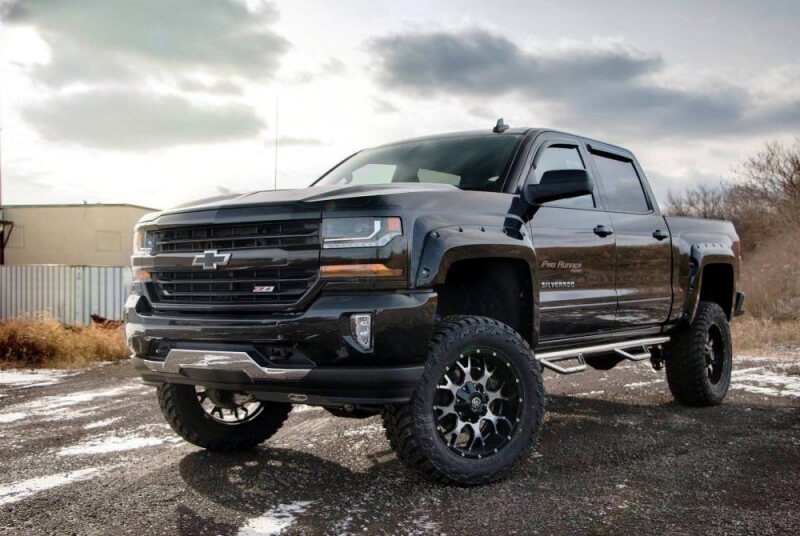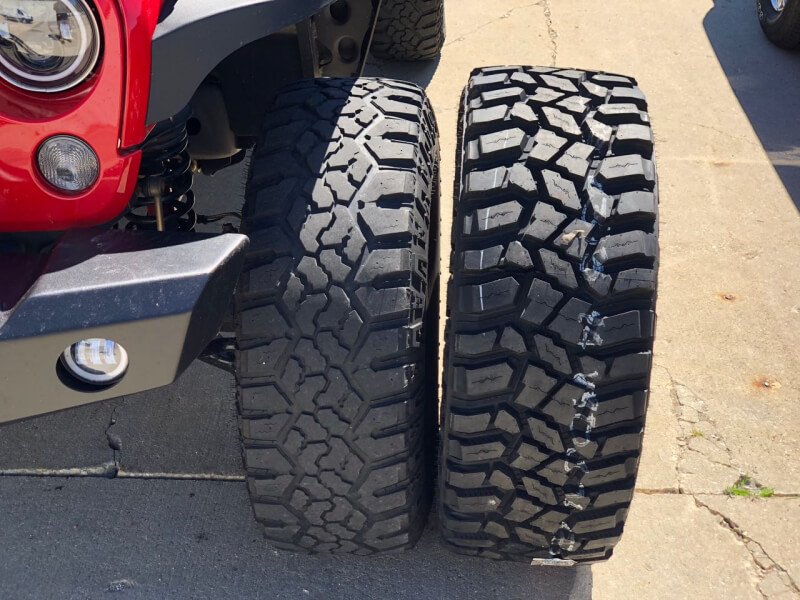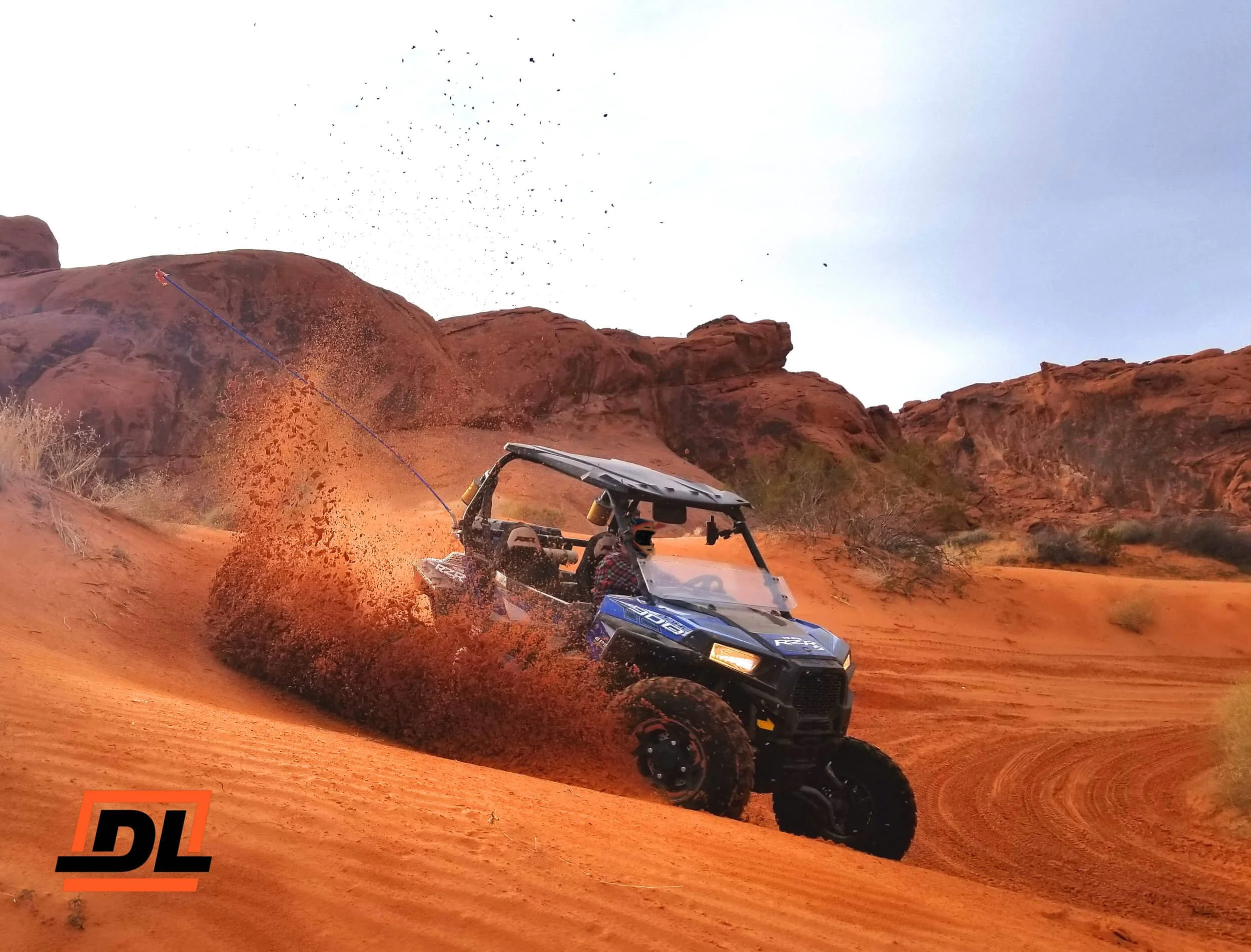Nothing compares to heading out on the trail in your truck or Jeep outfitted with mud tires, but what do you do when you use the same vehicle for your daily commute?
Do mud tires still make sense at this point, or should you consider all-terrain tires instead? Let’s examine the difference between mud tires and all-terrain tires and see what makes the most sense for you.
What are Mud Tires?
First, let’s define what we mean.
Mud tires feature an aggressive, heavy block tread pattern that’s designed exclusively for off-road use. They are ideal for uneven, rocky and muddy terrain. You will find mud-terrain tires in larger sizes with reinforced construction for maximum durability.
Some people also purchase mud tires just for the aggressive appearance although most users need them to head off-road. You know who you are.
Can You Use Mud Tires on the Street?
Yes, many mud tires are street legal and can be driven on the road while traveling highway speeds.
But just because you can do something, doesn’t mean it’s always the best option. If you don’t spend a lot of time driving in the mud, you might do better with all-terrain tires for your daily commute.
How Long Will Mud Tires Last?
It’s going to depend on your driving style, the tires you choose and the driving conditions. If your vehicle isn’t heavily modified, you might get around 40,000 miles with a mixture of street and off-road travel.
Depending on modifications though, you’re likely to see less than 20,000 miles out of some brands of mud-focused off-road tires.
Differences Between Mud-Terrain and All-Terrain Tires
Mud tires are designed to work best off-road within mud, sand, loose soil and jagged rocks. They come with a large tread block design which has deep and wide voids between them. This provides the room to dig into most off-road surfaces while the spaces between the knobs clear gravel, debris and mud.
Mud-terrain tires can often be heavy, noisy, and difficult to balance. They also provide clumsy handling and a rough ride on pavement. For people that only need to drive on the road for short distances, this won’t be a big deal. If, however, you drive often, you might not like the feel of mud tires on the street.
All-terrain tires feature smaller tread blocks and narrower voids. They are ideal for snowy, icy and wet conditions where mud tires don’t perform as well. Obviously, there isn’t as much raw off-road traction with this type of tire, but they run better on-road as a result of this design. AT tires offer a smoother on-street ride with less noise and better handling.
Any serious off-roader is going to discover serious disappointment when pushing the limit of an all-terrain tire’s traction. Still, they might be the best option for any vehicle that goes off-road and on the highway on a regular basis.
Disadvantages of Mud-Terrain Tires
There are several disadvantages to driving mud tires on the street.
Increased noise levels
The large tread blocks and depth will not help you to achieve a quiet ride. To see the proof of this, just look at what they do in Europe.
In some European countries, tires are evaluated by their noise level. Mud tires are exempt from this testing because they are significantly louder than on-road tires.
Of course, it doesn’t take a rocket scientist to figure this out; you’ve probably heard the roar of a mud-terrain tire on the road at least once in your lifetime.
Decreased fuel economy
To keep the mud tire rolling forward, there’s a lot of energy required. This leads to a decrease in fuel economy. If you want off-road performance plus additional fuel savings, then an all-terrain tire might be a better option.
Hard ride
Mud tires have a heavy-duty construction that adds thickness to the sidewall size. This increases abrasion resistance but creates a firm, hard ride. The rubber compounds are designed to wear far differently than, say, a performance summer tire on a performance car.
Decrease in snow and ice traction
You may think the wide scoops of a mud tire would help in snow, but in anything less than feet of snow they will actually be a detriment.
You won’t have decent traction on ice or snow with the blocky tread. If you plan to drive in these conditions, you might consider the smaller blocks found on an all-terrain tire instead.
Popular Mud Tires
While there’s a vast selection of mud tires to choose from, some brands and models excel above the rest. Some highly-rated mud tires include:
Goodyear Wrangler MT/R with Kevlar
BFGoodrich Mud-Terrain T/A KM2
Firestone Destination M/T
Dunlop Radial Mud Rover
Kumho Road Venture MT KL71
Advantage of All-Terrain Tires
AT tires offer the best of both worlds. You can find a set that looks equally as jagged and rough as your favorite mud tire with more on-road capability. The most significant difference will be that the all-terrain tire provides you with additional stopping power. This set also provides a more comfortable and quieter ride for your everyday commute.
All-terrain tires have more tread edges so they can grip surfaces better. In addition, all-terrain tires also provide better traction on snowy and wet roads. If you plan to drive both on-road and off-road, the all-terrain tire is usually a better option.
If tire shine on a Jeep floats your boat, we can’t stop you | source
Which is the Best Option for Daily Commutes?
If you don’t spend the majority of your time driving through sand and mud, then mud tires might not be the right addition to your truck or Jeep. Of course, many people will still opt for the mud tires because of the rugged, aggressive look, but there are other alternatives.
We called an office meeting to come to a consensus among ourselves, and most of our staffers agree that mud tires on a roadgoing vehicle are a waste for several reasons:
fuel economy is drastically reduced
noise is drastically increased
handling is compromised
In addition, full-on mud tires often cost far more than their A/T counterparts yet they often deliver 2/3 to 1/2 of the miles of a more traditional pavement-focused tire. That means you’re spending more to buy tires that last for fewer miles.
Every mile you spend driving a mud tire on pavement is money out the window. In many cases you could actually buy a second set of wheels just for your mud tires, drive on A/T tires daily, switch the sets when you go off-roading, and you’d still save money in the long run.
Hot take: Keep the mud tires for dedicated off-road vehicles instead. The mud-terrain tires provide the best ride while driving off-road but are far from the best option for highway travel.
What’s your experience with mud tires?
Do you have a vehicle equipped with mud tires? We would love to hear about your experience taking your truck or Jeep with mud tires on the road. Let us know how comfortable and quiet the ride is.











Hve you seen what Scott Steinberger did to this 2019 Can-AM X3 Rally UTV? When it was done they named it the “El Tigre”.